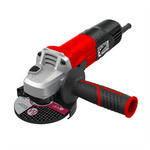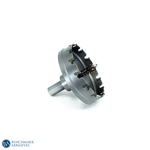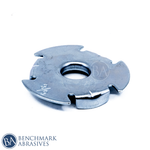
Abrasive Material Types & Industrial Applications of Abrasives

From the gleaming finish on your car to the smooth surface of your favorite wooden furniture, the secret behind a perfect finish often lies in a powerful, yet essential, tool: abrasives. Made of hard materials, abrasives are used in countless industrial and domestic applications to shape, smooth, and finish a wide variety of workpieces, from metal and wood to glass and plastic.
At their core, abrasives function by grinding or wearing away material, either by hand or with a machine. This process allows them to achieve a sleek, polished look or to slowly remove material until a precise form is achieved. Understanding the different types of abrasives is the first step toward mastering their many uses.
Related Article: What Is An Industrial Abrasive
Types of Abrasive Materials
Abrasives are broadly categorized into two main groups: natural and synthetic. Natural abrasives are found in the earth, while synthetic abrasives are manufactured. Synthetic options offer greater consistency and can be tailored for specific uses.
The most common types of synthetic abrasives are classified as either bonded or coated.
1. Bonded Abrasives
These are made when abrasive grains are "bonded" together using a strong adhesive to form a rigid, solid shape like a grinding wheel, cut-off wheel, or segment. They are used for heavy-duty applications such as cutting, grinding, and stock removal, and are often used with power tools like angle grinders or drill presses. The bonded structure ensures the grains stay together under extreme pressure to achieve their cutting objective.
Read More: Types of Cutting Tools
2. Coated Abrasives
Coated abrasives are created when abrasive grains are applied to a flexible backing material. Sanding discs, belts, sheets, and rolls are the most common examples of these materials, used extensively in finishing, sanding, and polishing applications. They are available with two types of abrasive layers:
- Open Coat: Approximately 50% to 75% of the surface is covered in abrasive grains, which helps prevent clogging on softer materials like wood or paint.
- Closed Coat: The entire surface is densely covered in abrasive grains, making it ideal for aggressive cutting and achieving a uniform finish on hard materials like metal.
The grains used in these abrasives include materials such as aluminum oxide, silicon carbide, garnet, zirconia alumina, and ceramic alumina.
Related Article: Guide to Industrial Sanding Belts
Understanding Abrasive Backing Types
The material to which the abrasive grains are adhered is called the backing. The backing provides strength, durability, and flexibility, and is composed of a make coat, the grains, and a size coat of adhesive. The most common backing types are paper, cloth, film, and fiber.
1. Paper Backings
Paper backings are categorized by weight using a letter system, from A (lightest) to F (heaviest). This letter grade helps identify the thickness and strength of the backing.
- Lightweight (A, B weights): Used for light to medium-grade sanding, often for hand sanding or use with small electric sanders.
- Medium-Weight (C, D weights): A standard thickness for general-purpose sanding, commonly used for sheets and discs.
- Heavyweight (E, F weights): The strongest and most durable papers, designed to support heavy grains for aggressive production sanding.
2. Cloth Backings
Made from cotton, rayon, or polyester, cloth backings are known for their flexibility and tear resistance. They are labeled with weights J, X, Y, M, S, T, and Z, which indicate their density and stiffness.
- Lightweight (J weight): The thinnest and most flexible, great for contour work.
- Medium-Weight (X weight): An average thickness that balances flexibility and durability, suitable for a wide range of general-purpose applications.
- Heavyweight (Y, M, S, T, Z weights): These are extremely durable and rigid, used for heavy-duty applications like grinding and stock removal.
3. Film Backings
The film backing is made of polyester, and they are stable, tough, and waterproof. They are ideal for applications that require a flat, consistent finish or involve wet sanding.
Applications of Abrasives

Abrasives are fundamental to countless manufacturing processes. Their industrial applications are typically grouped into the following main classifications:
- Cutting: Using a bonded abrasive wheel or tool to slice through a material and divide it into two or more pieces. An example is using a cut-off wheel to slice a metal pipe.
- Grinding: An abrasive machining process that uses a grinding wheel to shape and remove material with high precision, essential in manufacturing metal parts.
- Sizing: A process where an abrasive wears away a surface until it reaches an exact, predetermined form. This is crucial for creating parts with very tight tolerances.
- Sanding and Polishing: Sanding, the process of using coated abrasives like sandpaper to prepare a surface, is a fundamental step in achieving a smooth and finished look. This can range from removing rough spots to achieving a high-luster, mirror-like shine on metals, plastics, or wood.
- Honing: A low-speed abrasive process that uses a honing tool to produce a smooth, precise internal surface on a workpiece, commonly used for engine cylinder bores.
- Sharpening: Using abrasives to create a sharp edge on a tool, such as a knife or drill bit.
The Role of Abrasives in Key Markets
Abrasives are the backbone of many major industries. Their primary usage includes:
- Woodworking and Manufacturing: Used in the production of furniture, kitchen cabinets, and custom casework to shape and finish wood surfaces.
- Metal Manufacturing: Critical for shaping, sizing, and finishing light sheet metal, metal parts, and casings.
- Aerospace and Automotive: Used in the manufacturing of key components from fiberglass, plastics, and composites. In the automotive market, abrasives are essential for both manufacturing parts and for vehicle maintenance and repair, including bodywork and paint finishing.
- Marine Industry: Abrasives are crucial for building and maintaining boats and marine components, from shaping fiberglass to polishing hulls.
Why Choosing the Right Abrasive Matters
Using the correct abrasive is not just about getting the job done—it's about doing it efficiently, safely, and with a high-quality result. The key to a professional finish is selecting the right abrasive material, grit, and backing for your specific needs, which helps prevent damage and saves time. Whether you're a hobbyist or an industrial professional, understanding these principles is key to mastering your craft.
Know More About: Industrial Applications of Abrasives



































































